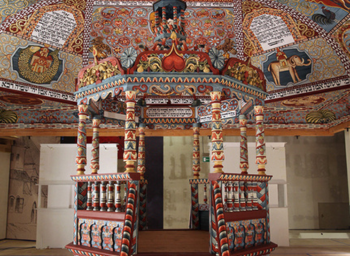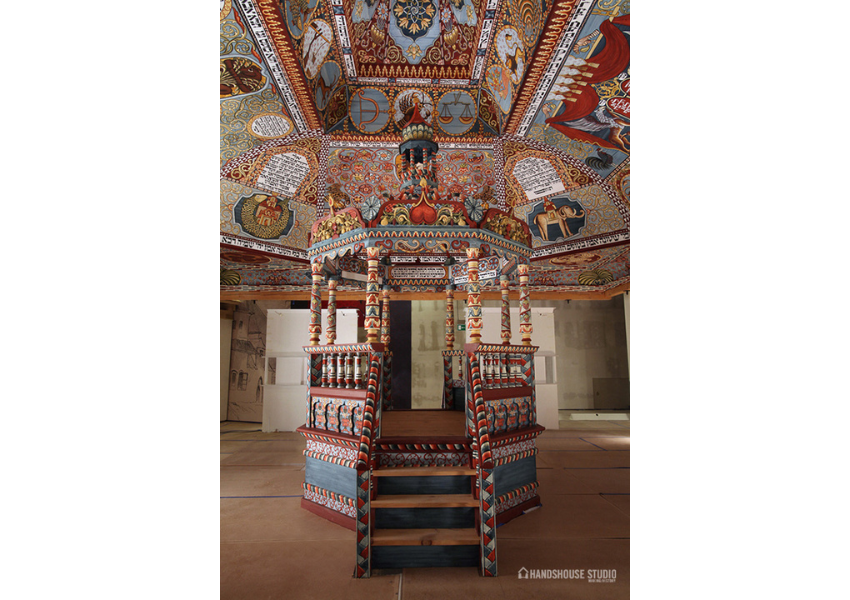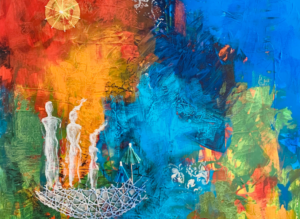A Portal to Gwoździec: The Bimah
Published Apr 22, 2023

A Portal to Gwoździec: The Bimah
Above: (20 sec) Timelapse of the assembly of the Gwoździec bimah at Handshouse Studio in Norwell, MA. Seen here completed and unpainted, this full-scale reconstruction is made up of over 150 handmade wooden parts. In 2013, all the parts were shipped to Poland, to be painted in a Handshouse workshop in Warsaw and installed under the Gwoździec painted ceiling in the Core Exhibition in the POLIN Museum. Courtesy of Handshouse Studio.
Project Overview:
Through the MAKING/HISTORY Wooden Synagogue Project, Handshouse produced an extensive collection of historical material research that is vital to the continued work of recovering lost heritage. We have also established a powerful educational model for learning-by-doing through workshops that collaboratively remake lost historical objects, reawakening whole worlds of both tangible and intangible cultural heritage. The calls for access to our research and continued interest in our unique hands-on educational approach lead us to explore new ways to expand our capacity to share our process and resources.
Through the support of Mass Humanities grant funding, and collaboration with the POLIN Museum, we are starting the next chapter of the MAKING/HISTORY: Wooden Synagogue Project, creating A Portal to Gwoździec: a window illuminating the history of wooden synagogues for a wider public.
The Bimah
Handshouse Studio created the Gwoździec Bimah Project to research and build a full-size replica of the Gwoździec Synagogue’s bimah through educational hands-on workshops.
The original Gwoździec Synagogue bimah was one of the oldest surviving documented bimahs in Europe until its destruction in 1918. The structure was originally carved and assembled between c. 1710 to 1725 in a regional style that combines late Baroque and Eastern European vernacular motifs. The bimah was brightly painted and located in the center of the painted prayer hall. It had an eight-sided shape with an open canopy that reflected the shape of the funneling and undulating tent-like structure of the interior ceiling of the synagogue. The bimah was a majestic raised platform flanked by two staircases and surrounded by elaborately paneled and spindled railings. Above the railings are mounted eight turned and carved columns that support an Italian Baroque-style open canopy crowned by a bold four-foot lantern with a spire reaching 16.5 feet. The eight sides are ten feet tall and are topped with eight ornately carved panels depicting lions, deer, and floral patterns. The bimah is an elegant example of the synthesis of Polish wooden cultural heritage and Jewish liturgical art.
The Finished Bimah

Above: The Handshouse reconstruction of the Gwoździec Synagogue painted ceiling and bimah in the Core Exhibition of the POLIN Museum of the History of Polish Jews. Courtesy of Handshouse Studio.
Click here to return to the homepage of the digital exhibit on Kolture.
Handshouse Studio is a non-profit, educational organization that works to illuminate history, understand science, and perpetuate the arts.
Reflections
What is a replica?
Is the Handshouse Studio reconstruction of the Gwoździec synagogue a replica? What is the difference between a replica and a reconstruction?
What is the meaning of repair?
If the original is gone, and there is nothing to be restored, is a reconstruction a restoration? How can rebuilding still be an act of repair?
If it is not original, is it an authentic object?
As Barbara Kirshenblatt-Gimblett Ronald S. Lauder Chief Curator, Core Exhibition of the POLIN Museum of the History of Polish Jews, asks “What constitutes an “original” or “actual” or “authentic” object?”
Want more?
Get curated JewishArts.org content in your inbox


